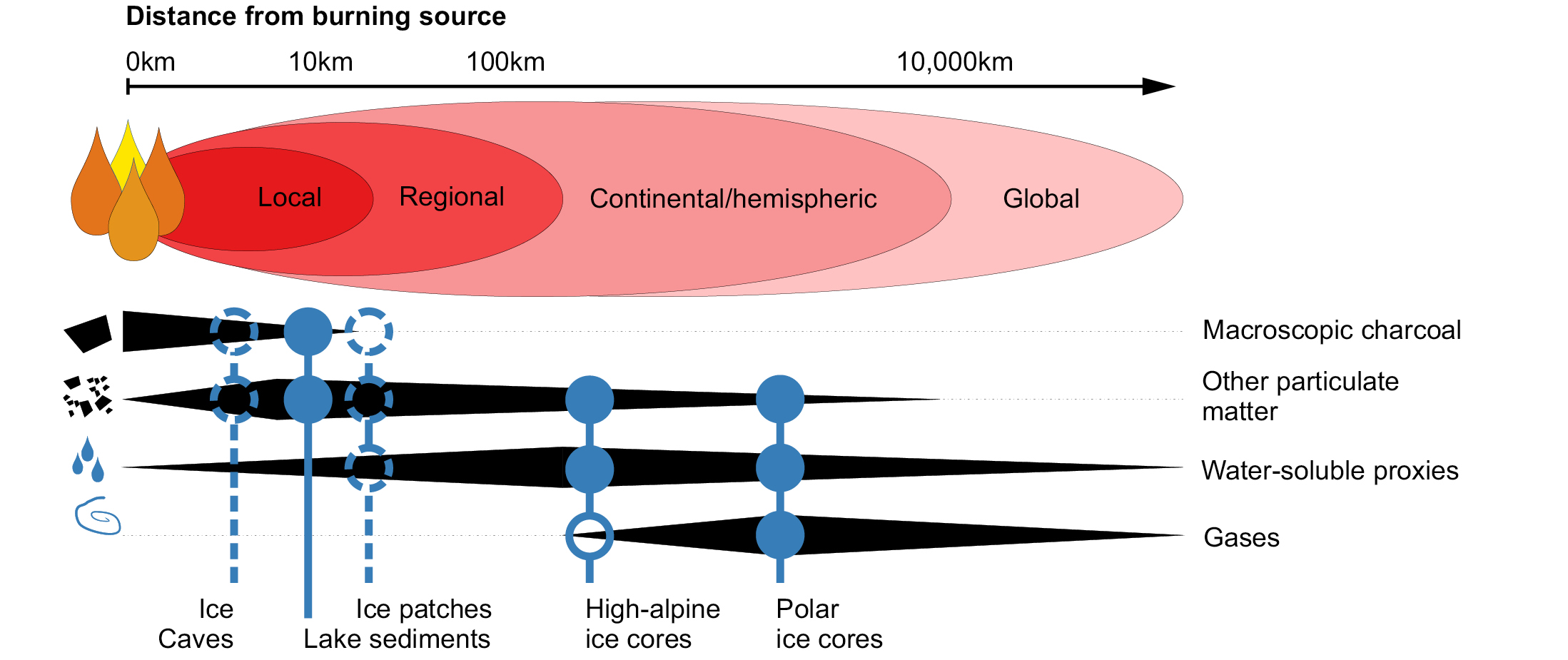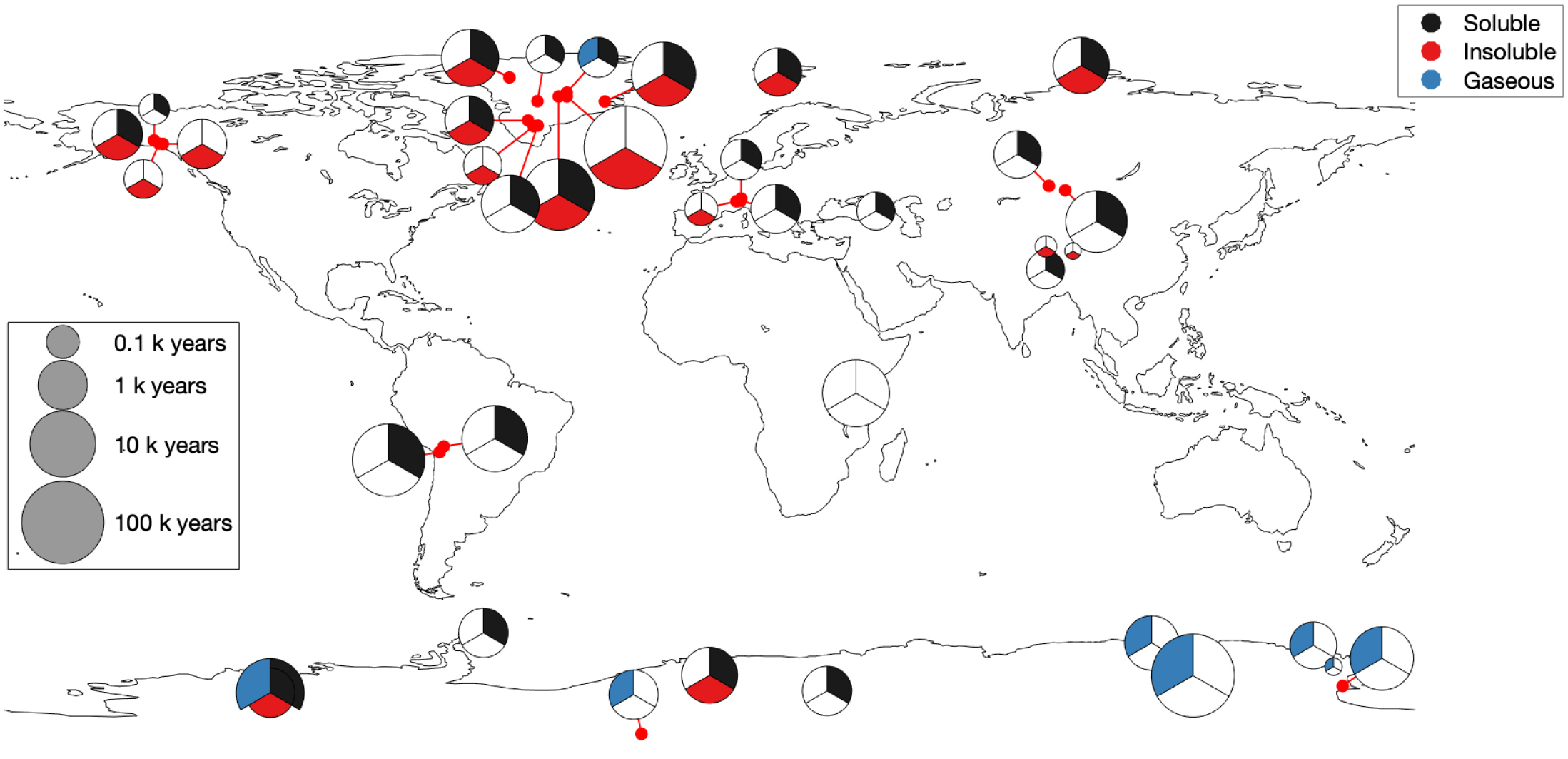- Home
- Publications
- PAGES Magazine
- Fire Trapped In Ice: An Introduction To Biomass Burning Records From High-alpine and Polar Ice Cores
Fire trapped in ice: An introduction to biomass burning records from high-alpine and polar ice cores
Brugger SO, Kirkpatrick L & Yeung LY
Past Global Changes Magazine
30(2)
106-107
2022
Sandra O. Brugger![]() 1, Liam Kirkpatrick
1, Liam Kirkpatrick![]() 2 and Laurence Y. Yeung
2 and Laurence Y. Yeung![]() 3
3
All authors contributed equally and are considered joint first authors.
Paleofire research is crucial for understanding long-term wildfire trends for fire and air quality management. Future work should close geographic gaps and incorporate cross-disciplinary collaborations for a holistic understanding of wildfires and their role in the climate system.
Fires are a unique element of the climate system. They are highly sensitive to regional climate, vegetation, and human factors, and serve as a significant driver of global climate and atmospheric composition (Legrand et al. 2016). Recent years were marked by devastating fire seasons worldwide with severe consequences for human health, economies, and ecosystems across continents. Yet, current biomass burning trends are a result of complex interactions between changing land-use practices, ecosystem dynamics, and climatic factors. Paleorecords provide a crucial context for both trends and drivers of burning, which help us understand how fires are changing now and how they might change in the future.
Efforts to build paleofire records began almost 100 years ago with charcoal analyses from Greenland sediments (Stutzer 1929). Early efforts to study paleofire in ice cores focused on black carbon (soot), but modern ice-core paleofire studies employ a range of proxies for biomass burning (Legrand et al. 2016) and utilize the long, accurate chronologies unique to ice cores (Martin et al. p. 100).
Paleofire proxies in ice cores
Fires yield products that are transported from the fire source region and deposited on ice. These fire tracers are preserved in the ice matrix as particulate matter, water-soluble species, and gases. They have varying levels of dilution, preservation potential, and specificity to biomass burning (Fig. 1). For example, black carbon is comprised of submicron-sized particles which can be produced by incomplete biomass combustion or by fossil-fuel burning (McConnell et al. 2007). Ammonium and potassium ions (which are water-soluble) also have multiple sources and thus correlate with wildfire activity only after accounting for the naturally occurring background (Rubino et al. 2016). Certain soluble organic molecules can present greater specificity to biomass burning—levoglucosan, for example (Simoneit 2002)—but atmospheric processes in gaseous and aqueous phases (Li et al. 2021) limit how well one can quantify past fire emissions from these ice-core records at present. Other small organic molecules produced in fires, such as acetylene and ethane (gaseous proxies), have simpler and better-understood atmospheric budgets that result in additional insights into burning history (Nicewonger et al. 2020). Finally, the isotopic compositions of gases such as methane are sensitive to changes in their emission sources, facilitating unique constraints on hemispheric- and global-scale biomass burning (Bock et al. 2017).
Note that while each proxy system has its unique advantages and shortcomings, the evidence for changes in paleofire regimes has been corroborated by multiple proxies in many cases, lending confidence to qualitative trends inferred for the last 2000 years. Recent reviews by Legrand et al. (2016) and Rubino et al. (2016) provide more comprehensive discussions about individual proxy systems.
Spatial coverage of ice-core paleofire records
The spatial distribution of available ice cores is skewed towards the poles, with a few high-alpine ice cores in temperate and tropical mountain ranges (Davidge et al. p. 98). Likewise, the coverage of ice-core-based paleofire reconstructions in polar regions is relatively extensive and includes many different particulate, water-soluble, and gaseous proxies (Fig. 2). Outside the polar regions, several multi- proxy paleofire reconstructions have been developed from the tropical South American Andes and the Himalayan region showing millennial-scale changes in fire regimes. Large-scale fire reconstructions based on black carbon, ammonium, nitrate, and microscopic charcoal in the temperate regions are concentrated in the Altai mountains in Central Asia and the European Alps. However, some regions with massive modern fire activity have not yet been investigated. For example, to our knowledge, there is not a single study investigating fire activity trends from the African continent, although Kilimanjaro, Tanzania, could provide a suitable ice archive.
Insights from ice fire records
Ice-core paleofire records show important trends for the last 2000 years, although a few records provide context from the late Pleistocene glacial cycles (Fig. 2). Two broad trends from these records are notable. First, decadal- to millennial-scale variability in fire activity has been inferred for the past 2000 years, arising from human activities and climatic driving forces. For example, global fire activity was higher during the Medieval Climate Anomaly (ca. 950–1250 CE) and then decreased into the Little Ice Age (ca. 1400–1850 CE, Rubino et al. 2016). Second, on glacial–interglacial timescales, large variations in land ice coverage, hydroclimate, and vegetation yielded higher amplitude changes in biomass burning compared to the Holocene (ca. 9700 BCE–modern). The stable isotopic composition of methane suggests that global biomass burning emissions increased between 115 kyr BP and 18 kyr BP, perhaps due to the extinction of megaherbivores that led to an increase in plant biomass (Bock et al. 2017). However, much remains to be learned about glacial–interglacial trends in biomass burning.
Future directions and conclusions
Ice-core records have most clearly illuminated the history of Northern Hemisphere paleofires over the past ~2000 years. Yet, key records from the Southern Hemisphere and Africa are still missing. In addition, proxy measures distinguishing between paleofire frequency and severity, on local to global scales, are needed. Filling in these gaps will improve our understanding of the relationship between fire, climate, ecosystems, and human activities. Fortunately, ice-core science is well suited for cross-disciplinary syntheses, which integrate paleofire reconstructions with atmospheric and ecological dynamics and past human impacts. Such research may incorporate multidisciplinary approaches and collaborations with experts in other fields.
New ice-core archives, such as from ice caves or alpine ice patches (Leunda et al. 2019), that have already yielded promising ice-core records could extend the spatial coverage of ice-core-based biomass-burning reconstructions. Comparison of paleofire records from ice cores with peat-, lake- and marine-sediment cores, as well as tree rings, also helps close geographic gaps and adds to a holistic understanding of past fire regimes. Sharing methodologies such as the application of black carbon methods to lake sediments (Chellman et al. 2018) and incorporating the measurements of traditional sediment–charcoal methods in ice-core science may facilitate comparison across paleoarchives. Due to the much larger particle size, charcoal fragments have a much shorter atmospheric lifetime and, thus, provide more local information compared to the more regional records derived from the smaller particles and gases recorded in ice cores (Fig. 1).
The use of multiple approaches is key to understanding regional patterns of past fire dynamics, fire severity, and sources for the individual biomass-burning proxies. Disentangling proxy sources is particularly important in the industrial period, given the influence of fossil-fuel and land-use emissions on individual fire proxies. Indeed, humanity's relationship with fire has likely been as variable as the cultures that comprise it; through time and space, social needs, traditions, and technological advances together have shaped the role of fire in society. Indigenous and local communities, in particular, should be included in the current fire dialogue to understand the role of fire in cultural traditions and oral histories. The broader paleofire community in the Global Paleofire Working Group highlighted the importance of combining paleofire research with traditional and Indigenous knowledge systems (Colombaroli et al. 2018).
We conclude that research on establishing paleofire records from ice cores is a relatively young field that is rapidly evolving. It has the potential to provide a much-needed long-term global and regional context for current fire adaptation strategies of society and natural systems (Watts and Brugger 2022) in a rapidly changing climate.
affiliationS
1Division of Hydrologic Sciences, Desert Research Institute, Reno, NV, USA
2Department of Earth Science, Dartmouth College, Hanover, NH, USA
3Departments of Earth, Environmental and Planetary Sciences and Chemistry, Rice University, Houston, TX, USA
contact
Sandra O. Brugger: sandra.brugger dri.edu
dri.edu
references
Bock M et al. (2017) Proc Natl Acad Sci USA 114: E5778-E5786
Brugger SO et al. (2022) Zenodo, doi:10.5281/zenodo.6850553
Chellman NJ et al. (2018) Limnol Oceanogr 16: 711-721
Colombaroli D et al. (2018) PAGES Mag 26: 89
Legrand M et al. (2016) Clim Past 12: 2033-2059
Leunda M et al. (2019) J Ecol 107: 814-828
Li Y et al. (2021) Environ Sci Technol 55: 5525-5536
McConnell JR et al. (2007) Science 317: 1381-1384
Nicewonger MR et al. (2020) J Geophys Res Atmos 125: e2020JD032932
Rubino M et al. (2016) Anthr Rev 3: 140-162
Simoneit BRT (2002) Appl Geochem 17: 129-162
Stutzer O (Ed) (1929) Fusit–Vorkommen, Entstehung und praktische Bedeutung der Faserkohle. Verlag von Ferdinand Enke, 139 pp

